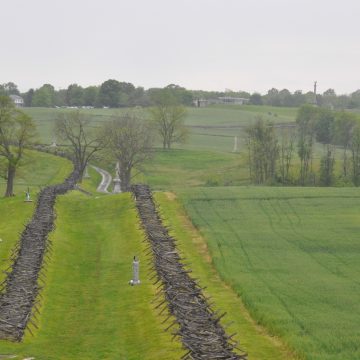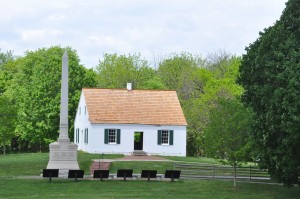
We are a military family and in honor of those who served, Sheila and I have visited several battlefields/military cemeteries in recent years. The 2016 destination? Antietam – a Civil War battlefield in Maryland named after the creek in Sharpsburg.
The night before the Battle of Antietam was to begin in the farming town, soldiers gathered in the woods behind Dunker Church. On September 17, 1862, Generals Robert E. Lee (Confederate) and George McClellan (Union) made their stands, determined to break (or hold) the Union front.
Antietam is remembered not only for its political importance, but also for being the bloodiest single day in American military history. About 23,000 souls (out of combined forces of about 100,000) were either killed, wounded or lost – a quarter of the area soldiers were out of commission, a devastating toll.
A film shown at the Antietam Visitor’s Center revealed that the battle itself was the result of accidentally acquired information about Lee’s plans, but some say that the incredible losses were the result of poorly formed battle strategy on both sides. Communication between the generals was spotty and at times, the enlisted men took things into their own hands after their officers were cut down.
The Sunken Road was the center of intense fighting for several hours and when the outnumbered Confederate forces were finally surrounded and killed, hundreds of bodies lay piled high throughout the length of what came to be called Bloody Lane.
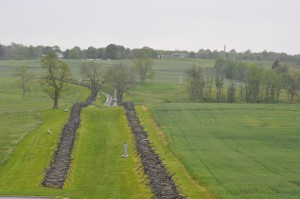
Burnside Bridge changed hands several times during the day. Whoever held the high ground was able to see the enemy approach and could easily pick the soldiers off, one by one.
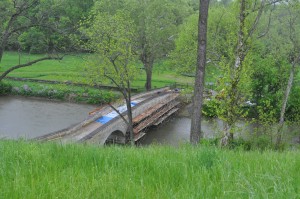
Eye witness accounts in letters reveal that often, single lines of men walked straight into the fire of the opposition, with little or no cover. Small groups continued to be picked off and there were so many bullets flying that it was hard to keep out of the way.
Nestled in a rolling valley in Maryland, today’s landscape is peaceful, beautiful – devoid of any signs of war except for the occasional statue or monument to the sacrifices of the brave men that lost their lives almost 154 years ago. Those rolling hills created several areas of high ground for the 500 cannons employed effectively by both sides.
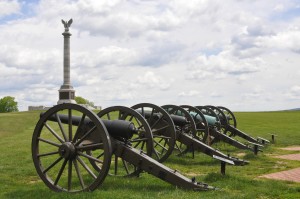
That restful view belies the actual aftermath of the Battle. So many men were wounded

that every building for miles around – school, home, business, barn – was used as a hospital. Never before had battlefield medicine been so severely tested. While the U.S. Sanitary Commission had been established the year before to help with distribution of supplies to hospitals, the aide was stretched beyond its limits.
The Sharpsburg region was devastated by the battle, racked by death and disease, stripped of food and supplies by both armies, and transformed forever by the impact of the fighting. Many local civilians lost their homes and farms to the combat and were never compensated by either side for that loss and destruction, despite their loyalty to the cause.
Clara Barton, who would later form the Red Cross, gave aid to soldiers from both sides and eventually organized the practice of giving assistance to civilians after natural disasters.
Neither side was a clear winner at the end of the day, but when the out manned and under supplied Confederates retreated back into Virginia, the Union counted it as a victory and Lincoln was able to use that as a bargaining chip to push the preliminary Emancipation Proclamation forward.
September 18, 1862 was a day that both sides gathered and tried to bury the dead, but
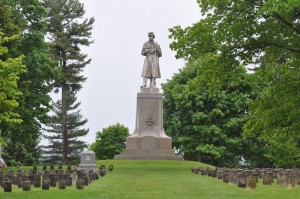
it took days to bury the 3,500 bodies. Union soldiers were re-buried in the area now known as Antietam National Cemetery, while Confederate soldiers were ultimately buried in local graveyards.
For more information about Antietam, the battlefield, and the museum, please visit:
https://www.nps.gov/anti/planyourvisit/hours.htm
http://www.civilwar.org/battlefields/antietam.html
https://www.nps.gov/anti/index.htm
http://www.npr.org/2012/09/17/161248814/antietam-a-savage-day-in-american-history
https://www.nps.gov/anti/learn/historyculture/arty.htm
Our visit to Antietam was a sobering experience; the exhibits pointing out so clearly the terrible price that both soldiers and civilians pay for the freedoms we enjoy. If you truly want to understand the importance of what transpired at Antietam on September 17, 1862, read up on it. Better yet, take time to visit the area.
*Photos by Patti Phillips

